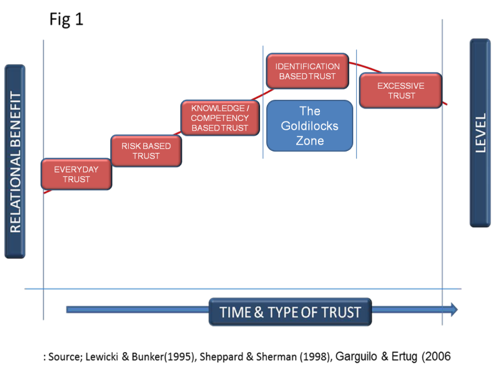Building Trust into your Customer Plans
Few people would doubt that building trust forms one of the foundations of a positive and mutually beneficial relationship. Yet, within B2B a lot of research into trust tends to be hypothetical. So, taking off the doctoral hat and putting on a practical one, we look at building trust into your customer plans, taking a proactive approach to embed them.
How can trust really be proactively applied? We know the areas that come together to develop trust within the relationship and maintain its position. The position we refer to as the Goldilocks zone. We use the following descriptors:
- People ‘yours and theirs.’ The people element of the relationship viewed from both sides.
- Your way of working. As the relationship develops and trust builds, so do the ways both sides work together.
- Mutual investments, during relationship development, both sides make joint investment in pursuit of mutually beneficial goals. This could manifest itself in co-funding a marketing campaign, KOL programme, co-creation of a solution, etc.
- Physical assets: our brands and equipment. This relates to the equipment we supply into the relationship either on loan, through extended credit or as part of the total portfolio and proposition. It can also refer to our brand strength in terms of value and strategic importance.
- The Degree of integration. This focuses on how close you work together and the level of the relationship. In some cases, the supplier will place staff within the customers operation to accelerate market development or focus on a specific specialist area. The converse is often the case with this being reciprocated with staff from the customer going to work within the suppliers facilities.
- Your practices and procedures. Over time you will develop practices and procedures between yourself and the customers organisation. As they develop they become barriers to exist and bonds within the relationship
- Joint action/working. This is relatively self explanatory as it represents the joint working and or joint actions you are undertaking within your customer.
- Commercial platform. Analysing the commercials to understand how financially important you are and to the category / partnership overall. Is it mutually acceptable.
- Contact. Frequency ,level and content.
- Behaviours. The demonstrated trust based behaviours within the relationship. E.g. They, demonstrate a similar approach, values and focus on quality.
- Attitudes. They come to the relationship with willingness and ‘can do’ approach. They put in just as much effort as you do to make it work. They are positive, pro-active and often come to you with improvement areas/ideas. Open, honest and welcome constructive criticism.
- Relational Intentions. The positive and or negative intentions one organisation has for the other in the form and conceptualisation of actions.
Each area has been developed into descriptors that allow you to check out the actual relationship versus the trust building area. e.g.,
People – Yours and Theirs
Yours:
Are you sending experts to interact and develop your customers from a technical and commercial perspective?
Is the level of decision-making and empowerment clear, enabling the right decisions to be made at the right time, without undermining either the manager or line manager.
Theirs:
You work with the customers management team, helping them on a technical basis and commercially ‘how to effectively develop’ the category or sector.
Turning the customers management team into experts in the categories in which we operate. Do they have people within their organisation dedicated to our category/sector enabling them to profitably develop them?
How to take descriptors from concept to reality?
The account team/client director come together in a facilitated session to work out where the relationship sits for each area against a scale of 1-7 low to high. The output from this session provides a clear view of the trust building areas already in place, and those that the team need to work on. On the basis that the customer has potential, and the relationship is worth developing, the team can move to action planning. In this day and age, it is unusual to come across an organisation that doesn’t have some form of customer planning for its largest key accounts. If you don’t … you need to start work on this.
- At this stage it is possible to weave in the areas identified as planned actions into your customer plans. I tend to use a simple approach as follows: Relationship driver: what, so what, now what, mutual value outcome, investment required, what’s the upside?
- The account team are now proactively applying trust building activities against a planned approach.
How do I know if it’s working?
The following metrics would be good indicators. The quality of the relationship, reapplying the internal relationship evaluation, are you selling more/selling better, has cost to serve come down? Have you moved status within the customer supplier hierarchy? Has the listed portfolio increased?
All of these are good and reasonable measures of a positive trust based relationship that sits in the ‘Goldilocks zone’ It is worth taking some time to select the right ones, and ensure they feature within your overall KPI dashboard. Lastly, Stevens (2015) suggests the relationship is recalibrated at regular intervals to prevent slipping back into dependency or tipping over into complacency. These can form a key part of your more formal customer review process.
If You Only Do One Thing…pro-actively plan your trust building.
Have a view on this? Tweet to @customerattune or Tweet to @MarkHollyoake
Contact us at hello@customerattuned.com
To download The Trust Ladder e-book fill out this form and we will e-mail you a copy
PLEASE CHECK YOUR SPAM FOLDER [Form id=”16″]
- Excessive Trust – When Trust Goes Wrong - October 29, 2024
- Identification Based Trust - October 21, 2024
- Introducing Knowledge Based Trust - October 15, 2024


